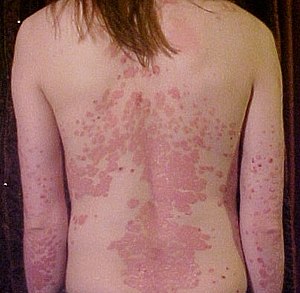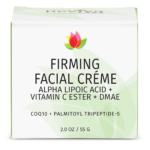Psoriasis
Psoriasis is a chronic, autoimmune condition in which the body produces too many skin cells, resulting in thick, red, and scaly patches on the skin. It can affect any part of the body, often the scalp, elbows, knees, and lower back, and can cause itching, burning, and pain. Psoriasis can flare up and become worse during periods of stress or cold weather, and is believed to be caused by an overactive immune system. Treatment typically involves topical creams, light therapy, and oral medications.
Psoriasis is a long-lasting, noncontagious autoimmune disease characterized by raised areas of abnormal skin. These areas are red, pink, or purple, dry, itchy, and scaly. Psoriasis varies in severity from small, localized patches to complete body coverage. Injury to the skin can trigger psoriatic skin changes at that spot, which is known as the Koebner phenomenon.
| Psoriasis | |
|---|---|
 | |
| Back and arms of a person with psoriasis | |
| Pronunciation | |
| Specialty | Dermatology |
| Symptoms | Red (purple on darker skin), itchy, scaly patches of skin |
| Complications | Psoriatic arthritis |
| Usual onset | Adulthood |
| Duration | Long term |
| Causes | Genetic disease triggered by environmental factors |
| Diagnostic method | Based on symptoms |
| Treatment | Steroid creams, vitamin D3 cream, ultraviolet light, Immunosuppressive drugs such as methotrexate |
| Frequency | 79.7 million / 2–4% |
The five main types of psoriasis are plaque, guttate, inverse, pustular, and erythrodermic. Plaque psoriasis, also known as psoriasis vulgaris, makes up about 90% of cases. It typically presents as red patches with white scales on top. Areas of the body most commonly affected are the back of the forearms, shins, navel area, and scalp. Guttate psoriasis has drop-shaped lesions. Pustular psoriasis presents as small, noninfectious, pus-filled blisters. Inverse psoriasis forms red patches in skin folds. Erythrodermic psoriasis occurs when the rash becomes very widespread, and can develop from any of the other types. Fingernails and toenails are affected in most people with psoriasis at some point in time. This may include pits in the nails or changes in nail color.
Psoriasis is generally thought to be a genetic disease that is triggered by environmental factors. If one twin has psoriasis, the other twin is three times more likely to be affected if the twins are identical than if they are nonidentical. This suggests that genetic factors predispose to psoriasis. Symptoms often worsen during winter and with certain medications, such as beta blockers or NSAIDs. Infections and psychological stress can also play a role. The underlying mechanism involves the immune system reacting to skin cells. Diagnosis is typically based on the signs and symptoms.
There is no known cure for psoriasis, but various treatments can help control the symptoms. These treatments include steroid creams, vitamin D3 cream, ultraviolet light, immunosuppressive drugs, such as methotrexate, and biologic therapies targeting specific immunologic pathways. About 75% of skin involvement improves with creams alone. The disease affects 2–4% of the population. Men and women are affected with equal frequency. The disease may begin at any age, but typically starts in adulthood. Psoriasis is associated with an increased risk of psoriatic arthritis, lymphomas, cardiovascular disease, Crohn's disease, and depression. Psoriatic arthritis affects up to 30% of individuals with psoriasis.
The word "psoriasis" is from Greek ψωρίασις, meaning "itching condition" or "being itchy" from psora, "itch", and -iasis, "action, condition".









